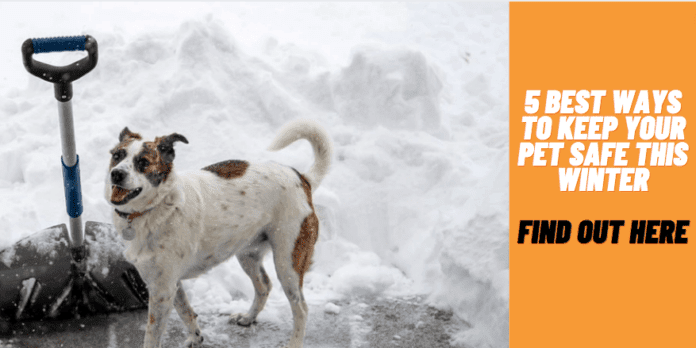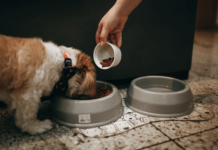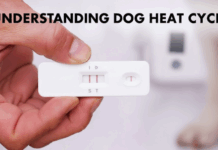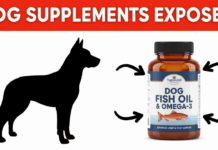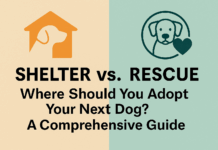Last Updated on July 26, 2024 by Dogs Vets
Best Ways to Keep Your Pet Safe This Winter
So, winter is here and you’re all set to take your pet out for a walk. The snow-covered sidewalks and frosty air are a great change from the hot summer days, but it’s important to keep in mind that there are some dangers to be mindful of this time of year.
Winter can be a challenging time for pets, especially if they’re not used to the cold weather. There are a number of things you can do to keep your pet safe and comfortable this winter.
The Complete Guide to Winter Pet Safety Tips
This is a guide for all the pet owners who want to make sure their furry friends are safe and sound during these cold months. Today, we will explore what to do if your pet gets hit by a car, lost in a storm or finds themselves stuck in a snow drift.
We will explore what to do if your dog gets caught on ice and how to avoid frostbite for both them and you!
Winter can be a challenging season for both humans and pets. As temperatures drop and the environment changes, it’s crucial for pet owners to be vigilant about their pets’ safety.
In this comprehensive guide, we will delve into various hazards your pets may face during the winter months and provide actionable tips to ensure their well-being.
Why Winter Pet Safety is Important
Winter poses unique risks for pets. From freezing temperatures to dangerous ice, understanding these hazards can help you protect your furry friends. Pets are more susceptible to cold-related illnesses and injuries, so proactive measures are essential.
Key Winter Hazards for Pets
Frostbite and Hypothermia
- Recognize Symptoms: Shivering, lethargy, and pale or blue skin are signs of frostbite and hypothermia. Immediate action is required if you notice these symptoms.
- Preventive Measures: Limit your pet’s time outside, dress them in warm clothing, and provide adequate shelter.
Ice and Snow Dangers
- Slippery Surfaces: Ice can cause slips and falls for both pets and owners. Ensure walkways are clear and use pet-safe ice melt products.
- Snow Drifts: Pets can get stuck in deep snow. Always supervise them and avoid letting them roam freely in heavy snow conditions.
Chemical Hazards
- Antifreeze Poisoning: Antifreeze is toxic to pets. Clean up spills immediately and store chemicals securely.
- De-icing Salts: These can irritate your pet’s paws. Rinse their paws after walks and consider using pet-safe alternatives.
What to Do If Your Pet Gets Hit by a Car
Accidents can happen, especially when visibility is low in winter conditions. If your pet gets hit by a car:
- Stay Calm: Approach your pet carefully to avoid causing them more distress.
- Seek Immediate Veterinary Care: Even if injuries seem minor, a professional evaluation is crucial.
- Provide Warmth: Keep your pet warm while waiting for help by covering them with a blanket.
Lost Pets During Winter
Pets can become disoriented in winter weather and may get lost. Here’s what to do:
- Immediate Search: Start searching as soon as you notice your pet is missing. Check familiar areas and call their name.
- Use Technology: Utilize social media and local lost pet networks to spread the word quickly.
- Update ID Tags and Microchips: Ensure your pet’s identification information is current to increase the chances of a safe return.
Dogs and Ice Safety
Ice can be particularly dangerous for dogs:
- Avoid Frozen Bodies of Water: Steer clear of lakes and ponds that may have thin ice.
- Use a Leash: Keep your dog on a leash near potentially hazardous areas.
- Rescue Techniques: If your dog falls through the ice, call for help immediately. Do not attempt to rescue them alone, as this can put both of you at risk.
Preventing and Treating Frostbite
Frostbite can affect both pets and humans:
- Dress Warmly: Use pet coats and booties to protect against the cold.
- Emergency Care: If frostbite occurs, warm the affected area gradually and seek veterinary assistance.
General Winter Safety Tips
- Regular Health Checks: Winter can exacerbate existing health issues. Regular vet visits are essential.
- Proper Nutrition: Pets may need extra calories to maintain their body heat. Consult your vet for dietary advice.
- Hydration: Ensure your pet has access to fresh water, as dehydration can occur in winter too.
Here are 5 best ways to keep your pet safe this winter:
-
Keep your pet warm. This means providing them with a warm bed or blanket to sleep in. It’s also important to make sure they have access to plenty of fresh water.
-
Be careful with antifreeze. Antifreeze is a common winter hazard for pets. It’s sweet-tasting, but it’s also poisonous. If your pet ingests antifreeze, it can be fatal. Keep antifreeze out of reach of your pets and clean up any spills immediately.
-
Watch out for ice and snow. Ice and snow can be slippery for pets, and they can also make it difficult for them to walk. Be careful when walking your pet in icy or snowy conditions. You may also want to consider using booties to protect their paws.
-
Keep your pet indoors. If possible, it’s best to keep your pet indoors during the winter months. This will help to protect them from the cold and from other winter hazards.
-
Get your pet microchipped. If your pet does happen to get lost, a microchip can help to reunite you with them.
Winter Safety Tips For Pets
As the cold season approaches, it’s crucial to ensure the safety and well-being of your beloved furry friends.
Winter can pose several challenges for pets, but with the right precautions and care, you can make sure they stay healthy and happy throughout this chilly season.
In this article, we will provide you with valuable tips and advice on how to keep your pets safe during the winter months.
- Provide Adequate Shelter: One of the most fundamental steps in ensuring your pet’s safety during winter is to provide them with proper shelter. Ensure that your pet has a warm and insulated space to retreat to when the temperature drops. Whether it’s a cozy indoor area or a well-insulated outdoor shelter, it’s essential to protect your pet from harsh cold winds and freezing temperatures.
- Layer Up: For dogs and cats that spend time outdoors, consider dressing them in appropriate winter clothing. Pet sweaters or jackets can help keep them warm, especially for smaller or short-haired breeds. Remember to choose clothing that fits comfortably and doesn’t restrict their movement.
- Keep Them Dry: Snow and sleet can make pets wet, which can lead to hypothermia. After outdoor excursions, make sure to dry your pet thoroughly, paying special attention to their paws, as ice and snow can accumulate between their toes. Towel-drying and providing a warm, dry environment is crucial.
- Limit Outdoor Time: During extreme cold spells, it’s advisable to limit your pet’s time outdoors. Shorten walks and playtime to prevent them from being exposed to freezing temperatures for extended periods. Additionally, be cautious of ice on sidewalks and roads, as it can be hazardous for both you and your pet.
- Maintain a Consistent Schedule: Maintain your pet’s regular feeding and exercise schedule, even during the winter months. Keeping their routine consistent will help them stay active and healthy. However, be flexible and adapt to the weather conditions, adjusting the time and duration of outdoor activities as needed.
- Watch Out for Antifreeze: Antifreeze is toxic to pets and has a sweet taste that can be enticing to them. Ensure that any spills are cleaned up promptly, and store antifreeze containers out of your pet’s reach. If you suspect your pet has ingested antifreeze, seek immediate veterinary assistance.
- Check for Frostbite and Hypothermia: Keep an eye out for signs of frostbite and hypothermia in your pets. Symptoms may include shivering, lethargy, pale skin, and cold extremities. If you notice any of these signs, bring your pet indoors, wrap them in warm blankets, and contact your veterinarian.
- Maintain a Healthy Diet: Pets may need additional calories during the winter to stay warm and active. Consult with your veterinarian to ensure you are providing the appropriate diet for your pet’s winter needs.
- Grooming Matters: Regular grooming is essential during the winter. Trim your pet’s fur to prevent ice and snow from accumulating on their coat, especially around their paws and belly. This will help them stay dry and comfortable.
- Watch for Signs of Cabin Fever: Lastly, be mindful of your pet’s mental health during the winter months. Lack of outdoor activity and stimulation can lead to cabin fever. Provide indoor toys, playtime, and affection to keep your pet engaged and happy.
What are the Risks your Pet Faces in the Winter
Tips: pet safety, winter pet risks, winter pet care, helping pets stay safe
3 Ways To Keep Your Pets Safe From The Cold
If you are thinking about getting a pet, it is important to be mindful of the cold weathers. Pets are very sensitive to sudden changes in temperature and can easily get sick.
1. Keep your pets safe by keeping them indoors during cold evenings.
2. Give them warm blankets, sheets, or jackets so they can stay warm and cozy at home.
3. Warm up the water in their bowls before giving it to them so they don’t have to drink cold water when thirsty or feel colder than they already do.
4 Tips for Preventing Dog Bites This Winter
Dog bite prevention tips, how to prevent dog bites in the winter.
1. Use a muzzle
2. Keep your dog on a leash
3. Teach your kids to respect dogs
4. Teach your dog to respond to “No!”
4 Ways to Keep Your Pet Safe This Winter
Here are a few ways to keep your pet safe this winter.
1. Make sure that the food and water bowls are not buried in snow or ice-covered. This can lead to dehydration, which can be even more dangerous for dogs than it is for humans.
2. Ensure that your pet always has a collar with identification tags, in case they get lost or wander off where people might not know who they belong to.
3. Check the area around your home and make sure there is no poison bait in sight, whether it be in the form of antifreeze or rat poison – something as small as a chewable mouse could kill a dog if eaten by mistake!
4. If you have an outdoor pet, make sure that they have water outside when it
Outdoor Precautions – What You Should Know About Snow For Your Pets
snow dangers for pets, how to keep dogs safe during snowstorms
It is not just you that needs to be careful during a snowstorm. Your pets also need to know what to do and how to prepare for the winter weather.
There are lots of dangers that your pet faces during the winter, and you need to make sure that they are prepared for them.
Below we will go over some of the dangers and tips on how to keep your animals safe during a snowstorm:
- Snow can get into their paws and cause frostbite or other problems. Make sure that you brush off any snow from their paws before they go back inside!
- Make sure they don’t drink too much cold water. The cold water could cause them stomach problems or even frostbite in their stomach.
Conclusion
The winter season brings a lot of benefits to people, from getting to enjoy the snow and ice to staying inside and curling up with a good book.
Winter also brings its share of hazards for our furry friends. This winter, take a few precautions to ensure that your beloved pets stay safe and warm this holiday season.
By following these tips, you can help your furry friend have a safe and happy winter season.
Remember, a little extra care can go a long way in keeping your pet warm, healthy, and loved all winter long.
Fact Check
We strive to provide the latest valuable information for pet lovers with accuracy and fairness. If you would like to add to this post or advertise with us, don’t hesitate reach us. If you see something that doesn’t look right, contact us!
